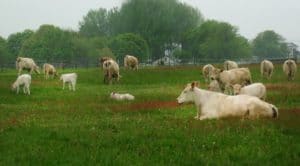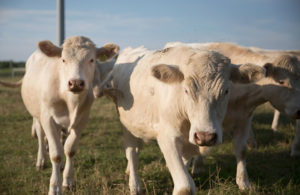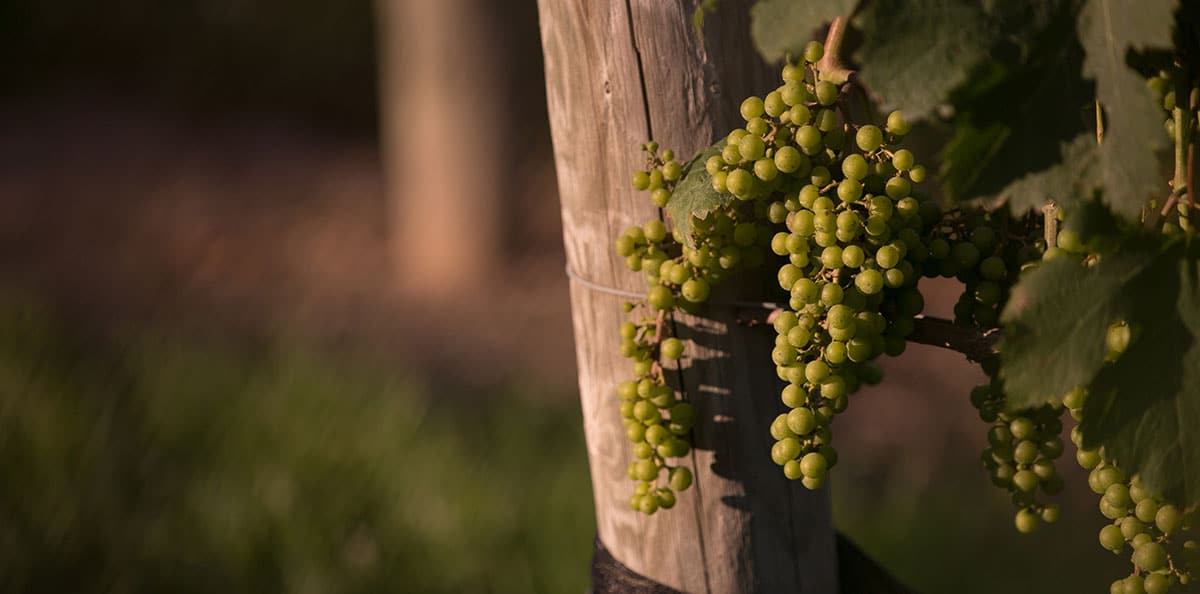
Russ McCall spent decades in the food and wine business, and one of his favorite places to visit has always been Burgundy, France. Homeland of Pinot Noir, the cool climate landscape in the eastern French countryside is also home to a particular breed of cattle. As Russ traveled through wine country, he would see herds of white Charolais grazing in the farmland between vineyards.
In April 2010, Russ had our first Charolais delivered to Cutchogue. Ten pregnant mothers lumbered off a trailer from Pennsylvania and into Corchaug Estate. The breed took very well to this climate, and to a grass-fed diet. To this day, we rotate pastures around the farm so they are rarely in the same place for long, a practice which keeps our soil in great condition and prevents our cattle from getting worms (and the subsequent need for antibiotics).
Charolais cattle originated in west-central to southeastern France, in the old French provinces of Charolles and neighboring Nievre. The exact origins of the Charolais are lost to us, but they must have originated from cattle found in the area. Legend has it that white cattle were first noticed in the region as early as 878 A.D., and by the sixteenth and seventeenth centuries were well and favorably known in French markets, especially at Lyon and Villefranche. Selection developed a white breed of cattle which, like other cattle of continental Europe, were used for draft, milk and meat.
The cattle were generally confined to the area in which they originated until the French Revolution. But, in 1773, Claude Mathieu, a farmer and cattle producers from the Charolles region, moved to the Nievre province, taking his herd of white cattle with him. The breed flourished there, so much so that the improved cattle were known more widely as Nivemais cattle for a time than by their original name of Charolais.
One of the early influential herds in the region was started in 1840 by Count Charles de Bouille. His selective breeding led him to set up a “herd book” in 1864 for the breed at Villars near the village of Magny-Cours. Breeders in the Charolles vicinity established a herd book in 1882. The two societies merged in 1919, with the older organization holding the records of the later group into their headquarters at Nevers, the capital of the Nievre province.
The French have long selected their cattle for size and muscling. They selected for bone and power to a greater extent than was true in the British Isles. The French breeders stressed rapid growth in addition to cattle that would ultimately reach a large size. These were men that wanted cattle that not only grew out well but could be depended upon for draft power. Little attention was paid to refinement, but great stress was laid on utility.
Introduction to the United States
Soon after the First World War, a young Mexican industrialist of French name and ancestry, Jean Pugibet, brought some of the French cattle to his ranch in Mexico. He had seen the Charolais cattle during World War I while serving as a French army volunteer and was impressed by their appearance and productivity. He arranged for a shipment of two bulls and 10 heifers to Mexico in 1930. Two later shipments in 1931 and 1937 increased the total number to 37 – eight bulls and 29 females. Not long after the last shipment, Pugibet died and no further imports were attempted.
 The first Charolais to come into the United States from Mexico are believed to be two bulls, Neptune and Ortolan, which were purchased from Pugibet by the King Ranch in Texas and imported in June 1936. Later imports of bulls were owned by some of the early “pioneers” in the industry: Harl Thomas, Fred W. Turner, C.M. “Pete” Frost, M.G. Michaelis Sr., and I.G. “Cap” Yates, all of Texas, J.A. “Palley” Lawton of Louisiana, and others.
The first Charolais to come into the United States from Mexico are believed to be two bulls, Neptune and Ortolan, which were purchased from Pugibet by the King Ranch in Texas and imported in June 1936. Later imports of bulls were owned by some of the early “pioneers” in the industry: Harl Thomas, Fred W. Turner, C.M. “Pete” Frost, M.G. Michaelis Sr., and I.G. “Cap” Yates, all of Texas, J.A. “Palley” Lawton of Louisiana, and others.
In the mid-1940s an outbreak of Hoof and Mouth Disease occurred in Mexico. As a result, a treaty between the United States, Canada and Mexico set up a permanent quarantine against cattle coming into any of these countries from Europe or any country in which Hoof and Mouth Disease was known to exist. This barred any further importation of French Charolais on this continent until 1965 when Canada opened the import doors via rigid quarantine both in France and in Canada.
Until the mid-1960s, all the Charolais in Mexico, the United States and Canada were descendants of this initial Pugibet herd. With the lightening of the import restrictions in Canada in the mid-1960’s fullblood Charolais were again imported from France. This allowed for the importation of new bloodlines, which meant new genetic material for tightly-bred Charolais pedigrees of the time. Several breeding herds were established in Canada, as well as the island of Eleuthera, in the Bahamas. Japan, England and Ireland also imported purebred Charolais directly from France. Offspring from these herds were later imported to the United States.
It has been said that no other breed has impacted the North American beef industry so significantly as the introduction of Charolais. The Charolais came into widespread use in the United States cattle industry at a time when producers were seeking larger framed, heavier cattle than the traditional British breeds. The increased use on the range indicates that the cows have performed well under a variety of environmental conditions. Their ability to walk, graze aggressively in warm weather, withstand reasonable cold, and raise heavy calves has drawn special praise from many that have them.


